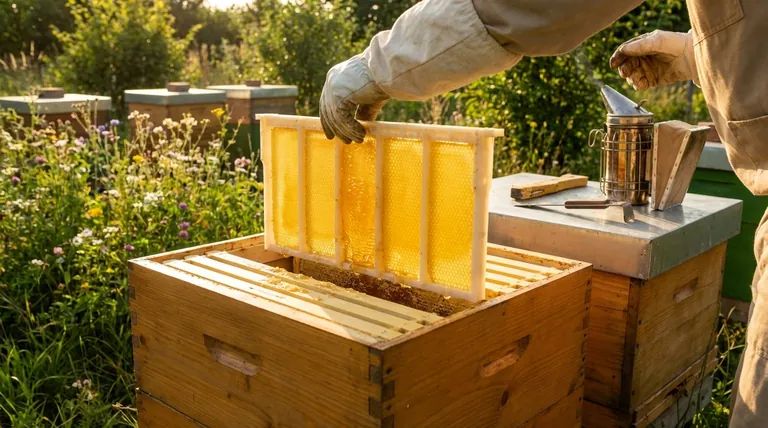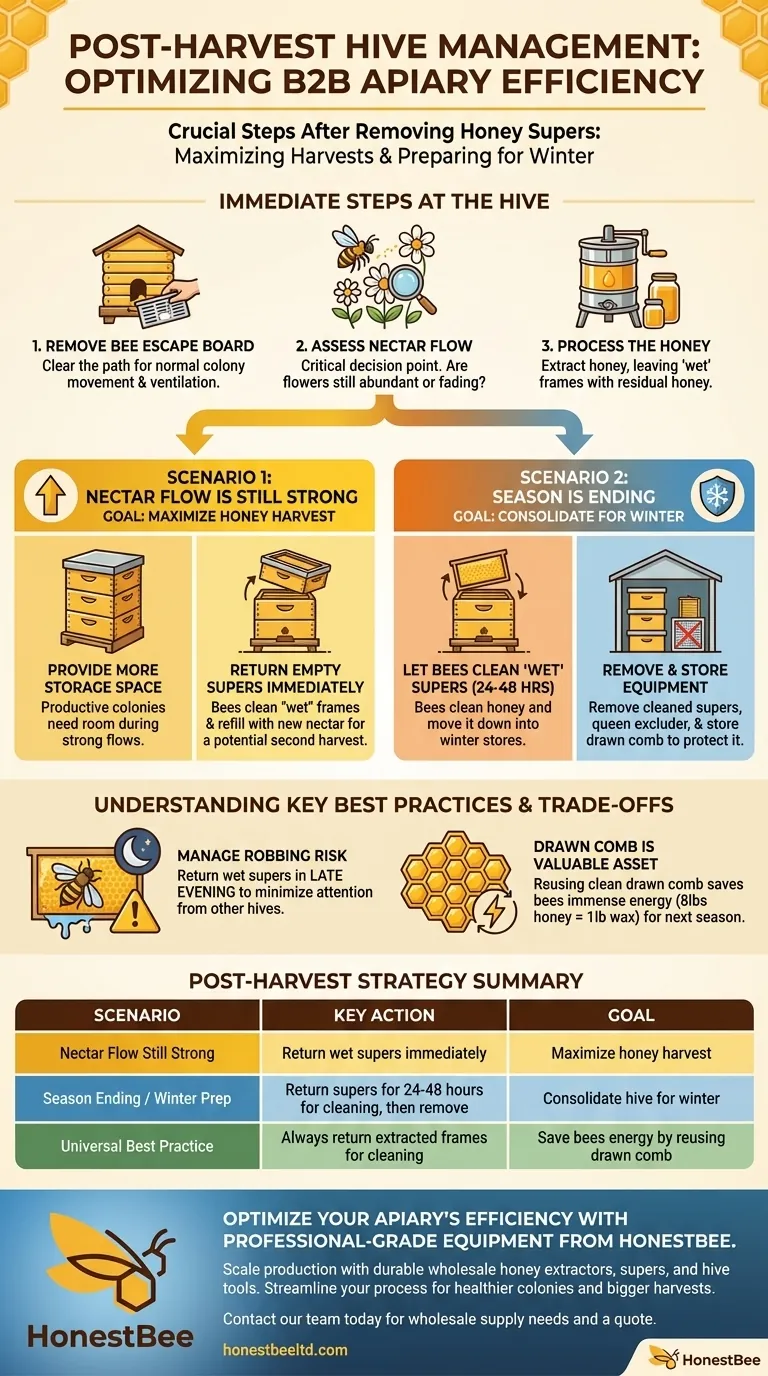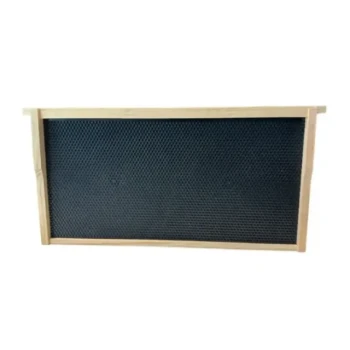After removing the honey supers, your immediate task is to remove any clearing devices like a bee escape board and then decide what to do with the now-empty frames and supers. This decision is not arbitrary; it depends entirely on the time of year and the availability of a continued nectar flow. The goal is to either give the bees more storage space or begin consolidating the hive for winter.
Your post-harvest strategy is a critical management decision that impacts both future honey production and the colony's winter survival. The core principle is to return the "wet," extracted frames to the hive, allowing the bees to clean them and preserve the valuable drawn comb for future use.

The Immediate Steps at the Hive
Once the full supers are safely away for extraction, your work at the apiary is not quite finished. A few simple steps are required to reset the hive and prepare it for what comes next.
Remove the Bee Escape Board
If you used a clearer board (also called a bee escape) to empty the supers of bees, your first step is to remove it. This device is designed to be a one-way door and leaving it in place will disrupt the colony's normal movement and ventilation between the brood boxes and any remaining supers.
Assess the Nectar Flow
This is the most important factor in your decision-making process. Observe your local environment. Are there still abundant flowers blooming? Is it early or mid-season? Or are you in late summer or early fall, with the primary nectar sources fading? Your assessment here dictates your next move.
Process the Honey
The removed supers should be taken to a clean, bee-proof location for extraction. This process involves uncapping the wax-sealed honeycomb, spinning the frames in an extractor to remove the honey, and filtering the final product. After extraction, you are left with "wet" frames—frames that are empty of honey but still coated in a sticky residue.
Scenario 1: The Nectar Flow is Still Strong
If you are harvesting in the middle of a strong nectar flow, your goal is to get the bees back to work storing honey as quickly as possible.
Provide More Storage Space
A productive colony can quickly fill available space during a strong flow. Returning the now-empty supers gives them the room they need to continue foraging and storing nectar.
Return the Empty Supers
Place the "wet" supers and their frames back onto the hive, typically above the queen excluder and brood boxes. The bees will immediately begin cleaning the residual honey from the frames and will start refilling the cells with new nectar.
Prepare for a Second Harvest
By providing this new space, you enable the colony to produce a second, or even third, crop of honey. Depending on the strength of the flow, you could be ready for another harvest in just a few weeks.
Scenario 2: The Season is Ending
If the main nectar flow is over, your priorities shift from honey production to winter preparation. Adding large, empty supers is no longer beneficial.
Consolidate the Hive for Winter
The colony's focus is now on storing enough honey in the brood boxes to survive the winter. Your goal is to help them consolidate their resources and remove any unnecessary space that they would have to heat and defend.
Let the Bees Clean the "Wet" Supers
Even if the season is over, you should still return the wet supers to the hive for a short period. Place them on top of the hive for 24-48 hours. The bees will efficiently clean every last drop of honey and move it down into their winter stores, leaving you with clean, dry frames.
Remove and Store Equipment
Once the bees have cleaned the frames, remove the supers for the season. Store the drawn comb in a dry, pest-free location. This protects it from wax moths and ensures you have a valuable head start for the following spring. At this time, you should also remove the queen excluder to allow the winter bee cluster to move freely.
Understanding the Trade-offs
Proper post-harvest management is about efficiency, but it also involves mitigating risk. Understanding the potential downsides is the mark of an experienced beekeeper.
The Risk of Robbing
Returning wet supers can excite your bees and, unfortunately, bees from other hives. This can trigger a "robbing frenzy," where stronger colonies attack weaker ones to steal their stores. To minimize this risk, return wet supers in the late evening when most foragers have stopped flying for the day.
Drawn Comb: Your Most Valuable Asset
Bees must consume approximately 8 pounds of honey to produce just 1 pound of wax. Pre-drawn comb is therefore an incredibly valuable resource. Returning frames for cleaning and properly storing them saves the colony an immense amount of energy, which can be redirected toward brood rearing and honey production next season.
Making the Right Choice for Your Goal
Your actions after pulling honey should align with your specific objective for the colony at that moment in the season.
- If your primary focus is maximizing the honey harvest: Return the empty supers immediately after extraction to capture the rest of the season's nectar flow.
- If your primary focus is preparing the hive for winter: Return the wet supers for only 24-48 hours for cleaning, then remove and store them to consolidate the hive.
- If your primary focus is colony health and efficiency: Always return the extracted frames for cleaning, as reusing drawn comb saves the bees enormous amounts of energy for the next season.
Ultimately, your post-harvest actions directly influence the colony's ability to thrive through the winter and prosper in the following spring.
Summary Table:
| Scenario | Key Action | Goal |
|---|---|---|
| Nectar Flow Still Strong | Return wet supers immediately | Maximize honey harvest |
| Season Ending / Winter Prep | Return supers for 24-48 hours for cleaning, then remove | Consolidate hive for winter |
| Universal Best Practice | Always return extracted frames for cleaning | Save bees energy by reusing drawn comb |
Optimize your apiary's efficiency with professional-grade equipment from HONESTBEE. Proper post-harvest management is crucial, and having the right tools makes all the difference. Whether you're a commercial apiary scaling up production or a distributor supplying the beekeeping community, our wholesale-focused operations provide durable honey extractors, supers, and hive tools designed for high-volume, seasonal workflows. Let us help you streamline your process for healthier colonies and bigger harvests.
Contact our team today to discuss your wholesale supply needs and get a quote.
Visual Guide

Related Products
- Professional 500g Sectional Comb Honey Frame System for Beekeeping
- Plastic Honey Comb Frames Cassette Box for Honey
- Professional In-Hive Bee Feeder HONESTBEE Frame for Beekeeping
- Heart-Shaped Comb Honey Frame and Honeycomb Cassette
- Plastic Bee Frame Beekeeping Hive Frames for Wholesale
People Also Ask
- When should I pull my honey supers? Harvest at the Perfect Time for Quality Honey
- How do you inspect honey frames? Master the 70-80% Rule for Healthy Hives
- Why might a customer look for shallow equipment in a store? To Reduce Weight and Enhance Hive Management
- How long does it take for bees to fill a frame with honey? It Depends on These 4 Key Factors
- What frame to use for honeycomb? Choose the Right System for Pure, Edible Comb



















